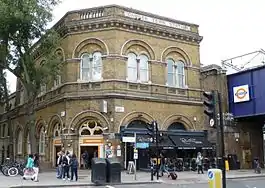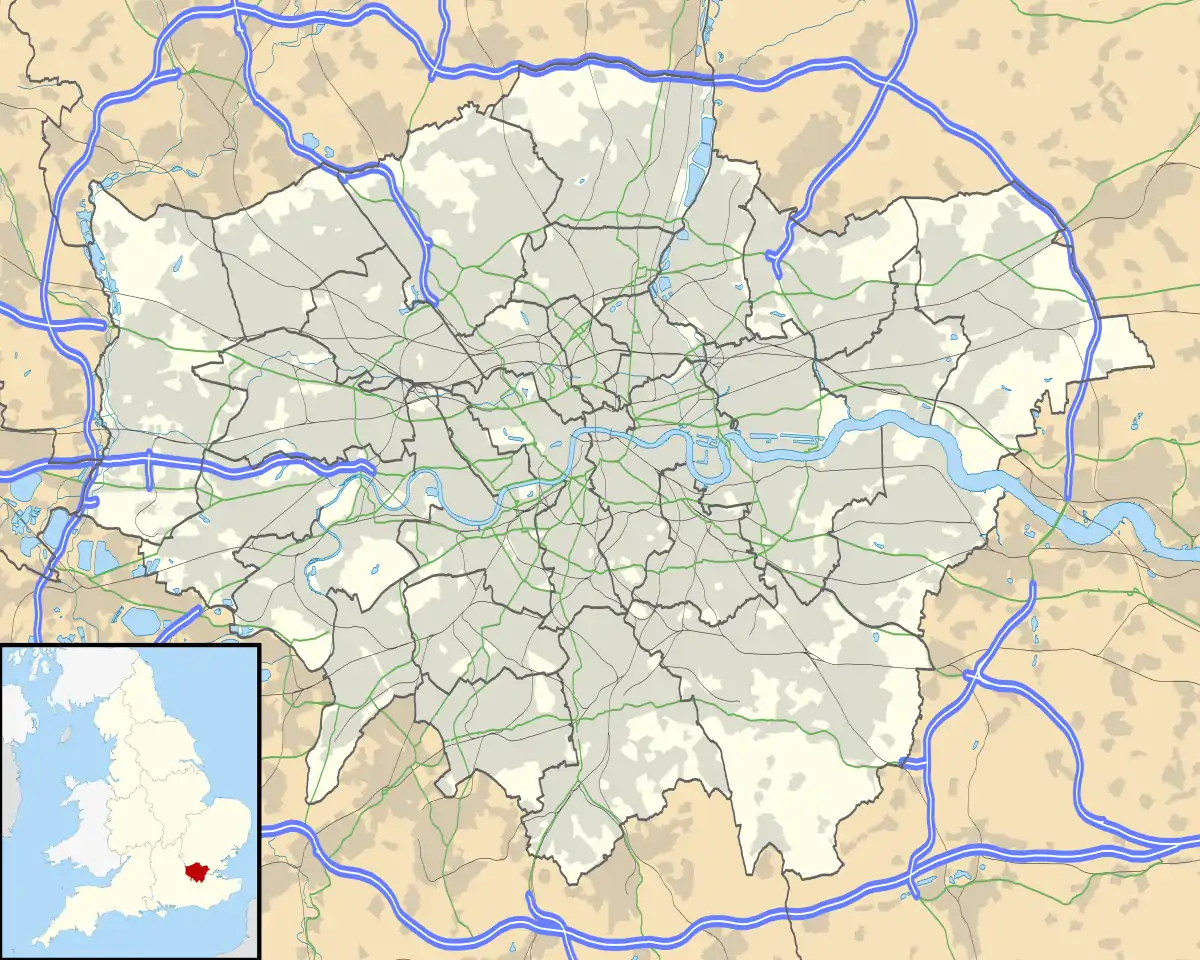Camden Road railway station
Camden Road railway station in the London Borough of Camden, north London, is operated by London Overground. It is on the North London line and in Travelcard Zone 2.
| Camden Road | |
|---|---|
 | |
 Camden Road Location of Camden Road in Greater London | |
| Location | Camden Town |
| Local authority | London Borough of Camden |
| Managed by | London Overground |
| Owner | Network Rail |
| Station code | CMD |
| DfT category | D |
| Number of platforms | 2 |
| Accessible | Yes[1] |
| Fare zone | 2 |
| OSI | Camden Town |
| National Rail annual entry and exit | |
| 2015–16 | |
| – interchange | |
| 2016–17 | |
| – interchange | |
| 2017–18 | |
| – interchange | |
| 2018–19 | |
| – interchange | |
| 2019–20 | |
| – interchange | |
| Key dates | |
| 7 December 1850 | first station opened |
| 5 December 1870 | resited |
| 25 September 1950 | Renamed (Camden Road) |
| Other information | |
| External links | |
| WGS84 | 51.5418°N 0.1388°W |
The first Camden Road station was opened by the North London Railway in 1850 on the east side of what is now St. Pancras Way. It was renamed Camden Town on 1 July 1870, but closed on 5 December the same year when it was replaced by the current station, a short distance to the west.[4]
The station is at the corner of Royal College Street and Camden Road. Designed by Edwin Henry Horne, it opened as Camden Town by the North London Railway on 5 December 1870, but was renamed Camden Road on 25 September 1950 to avoid confusion with the London Underground Northern line Camden Town which had opened in 1907. Thus, between 1907 and 1950, there were two stations called Camden Town. It remains Horne's only station still operating as such.[5]
The present Camden Town London Underground station is 450 metres to the southwest of this station.[6][7] It is one of the few railway stations in England in which there is a police station.
In addition to the frequent local passenger service, the station is a busy location for freight traffic due to its proximity to the junctions linking the North London line to both the West Coast Main Line at Camden Junction (via the now closed station at Primrose Hill) and the East Coast Main Line at Copenhagen Junction. The former is particularly well used by container trains from the deep water ports at Felixstowe and Tilbury to various terminals in the Midlands and North West of England; it also carried a passenger service (between Watford Junction and Broad Street/Liverpool Street) until 1992.
Services
To allow four-car trains to run on the London Overground network, the North London line between Gospel Oak and Stratford closed in February 2010, and reopened on 1 June that year, in order to install a new signalling system and to extend 30 platforms. After the reopening the work continued until May 2011 with a reduced service and none on Sundays.[8]
The typical weekday service in trains per hour is:
- 4 westbound to Richmond via Willesden Junction.
- 2 westbound to Clapham Junction also via Willesden Junction (no late evening service)
- 6 eastbound to Stratford via Highbury & Islington.[9] Some early morning and late night trains start or terminate here.
There is now no normal passenger service on the line from Camden Road to Willesden Junction Low Level via Queens Park, though the route can be (and is) used if the line via Hampstead Heath is blocked for any reason.
Connections
London Buses routes 29, 46, 253 and 274 and night routes N29, N253 and N279 serve the station.
There is also an official out of station interchange with Northern Line services at the nearby Camden Town underground station.
Camden Highline
In the future there may be a walking connection to and from King's Cross. The Camden Highline is a proposed public park and garden walk transforming a disused section of the North London Line between the two stations.[10]
A community group of the same name is proposing to bring back the 0.75-mile-long (1.21 km) railway into public use as an elevated linear park and greenway.
The project was envisioned by a geographer, Oliver O'Brien in 2015,[11] and promoted by Camden Town Unlimited.
In 2017 a crowdfunding campaign raised £64k using the Spacehive platform and received 314 donations including the Mayor of London, Sadiq Khan who said: "This innovative project has the potential to become a real asset for Camden and is a great example of a local community taking an idea and garnering support in order to make it a reality. I look forward to seeing it develop."[12][13]
The project started fundraising the construction costs in August 2019.[14][15]
In 2020 an international competition was held to find a design team and 76 bids were received. Entrants included Adjaye Associates, AL_A, AHMM, Asif Khan, Coffey Architects, Cullinan Studio, CZWG, David Kohn, Grant Associates, Hawkins\Brown, Jamie Fobert Architects, LDA, Lifschutz Davidson Sandilands, Migrants Bureau, Weston Williamson, and Zaha Hadid Architects. International submissions were also lodged by BIG, Snøhetta. West 8, and Diller Scofidio + Renfro.
The competition shortlist included the 2019 RIBA Stirling Prize contenders Feilden Fowles Architects; London-based Benedetti Architects; Southwark's We Made That with Hassell, Agence Ter of Paris; and US-based James Corner Field Operations, which led the team behind New York's High Line.[16]
References
- "Step free Tube Guide" (PDF). Transport for London. May 2020. Archived (PDF) from the original on 7 August 2020.
- "Out-of-Station Interchanges" (Microsoft Excel). Transport for London. 2 January 2016. Retrieved 28 August 2016.
- "Station usage estimates". Rail statistics. Office of Rail Regulation. Please note: Some methodology may vary year on year.
- The Forgotten Stations of Greater London by J.Connor and B.Halford-page 25
- Williams, Michael (2010). On The Slow Train: Twelve Great British railway journeys. London: Preface Publishing. p. 111. ISBN 978-1-8480-9207-5.
- Walking directions to Camden Town tube station from Camden Road railway station
- However, the accompanying 2008 photograph shows the original name ("Camden Town Station") still displayed on the parapet of the station building of what is now Camden Road station.
- "London Overground to close from Gospel Oak to Stratford as part of £326m upgrade to deliver longer, more frequent trains". TfL. 15 February 2010. Retrieved 29 May 2011.
- Table 59 National Rail timetable, May 2016
- Richardson, Tim (14 August 2017). "The Garden Bridge is dead, long live the Camden Highline". The Telegraph.
- O'Brien, Oliver (8 December 2015). "The Camden High Line". Urban/Rural.
- Simpson, Fiona (14 August 2017). "The Garden Bridge is dead, long live the Camden Highline". The Telegraph.
- Richardson, Tim (29 July 2017). "Sadiq Khan throws weight behind Camden highline project". Evening Standard.
- King, Jon (2 February 2018). "Camden Highline team in crowdfunding bid as garden walkway plan clears a hurdle". Ham & High.
- Howell, Madeleine (23 September 2018). "The battle to build London's own Highline - a 'green artery' for Camden and King's Cross". The Telegraph.
- Fulcher, Merlin (3 November 2020). "Exclusive: Finalists in Camden Highline competition named". Architects' Journal.
External links
| Wikimedia Commons has media related to Camden Road railway station. |
- Train times and station information for Camden Road railway station from National Rail
| Preceding station | Following station | |||
|---|---|---|---|---|
| North London Line | towards Stratford |
|||
| Former Service | ||||
| West Hampstead towards Basingstoke |
Anglia Railways London Crosslink |
Highbury & Islington towards Norwich | ||
| Disused railways | ||||
| Kentish Town West | North London-Watford Link (LNWR suburban system) |
Maiden Lane | ||
| Primrose Hill | Caledonian Road & Barnsbury | |||